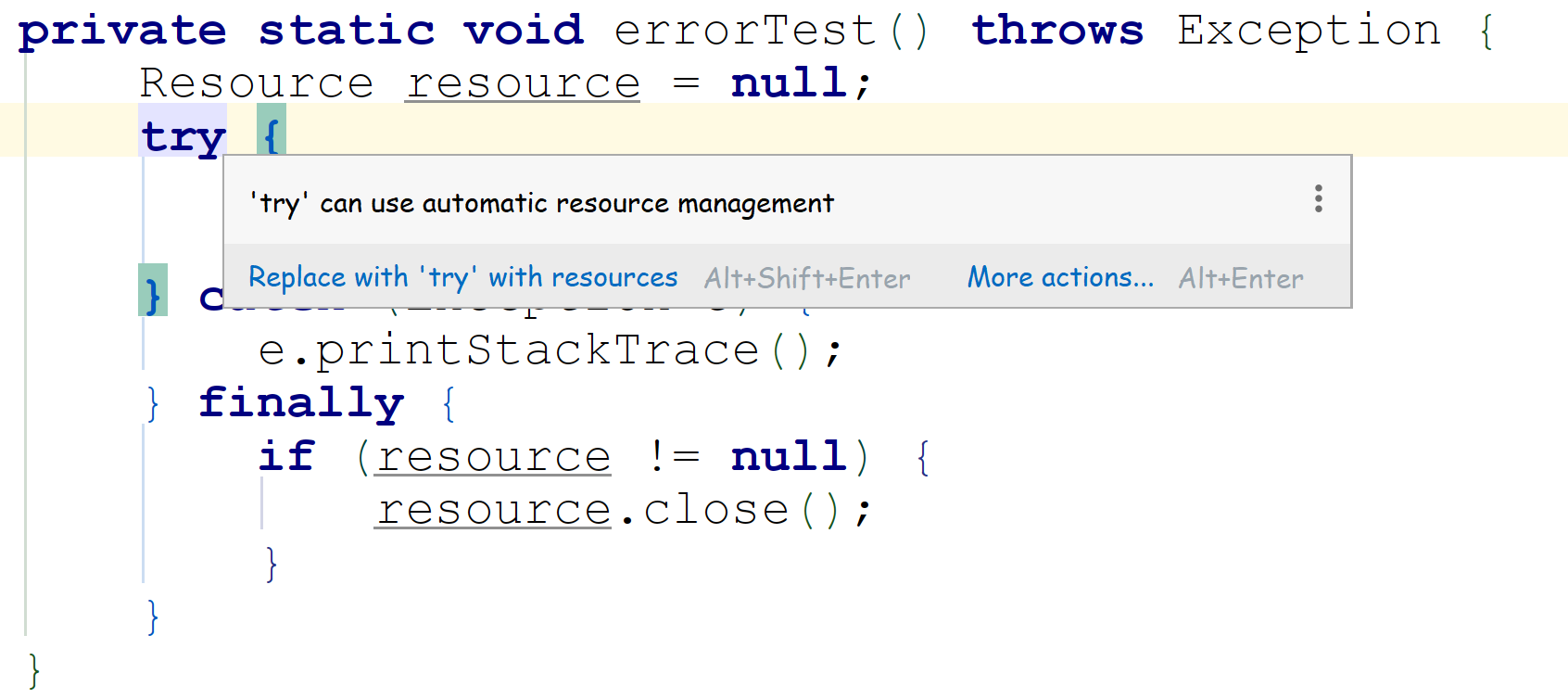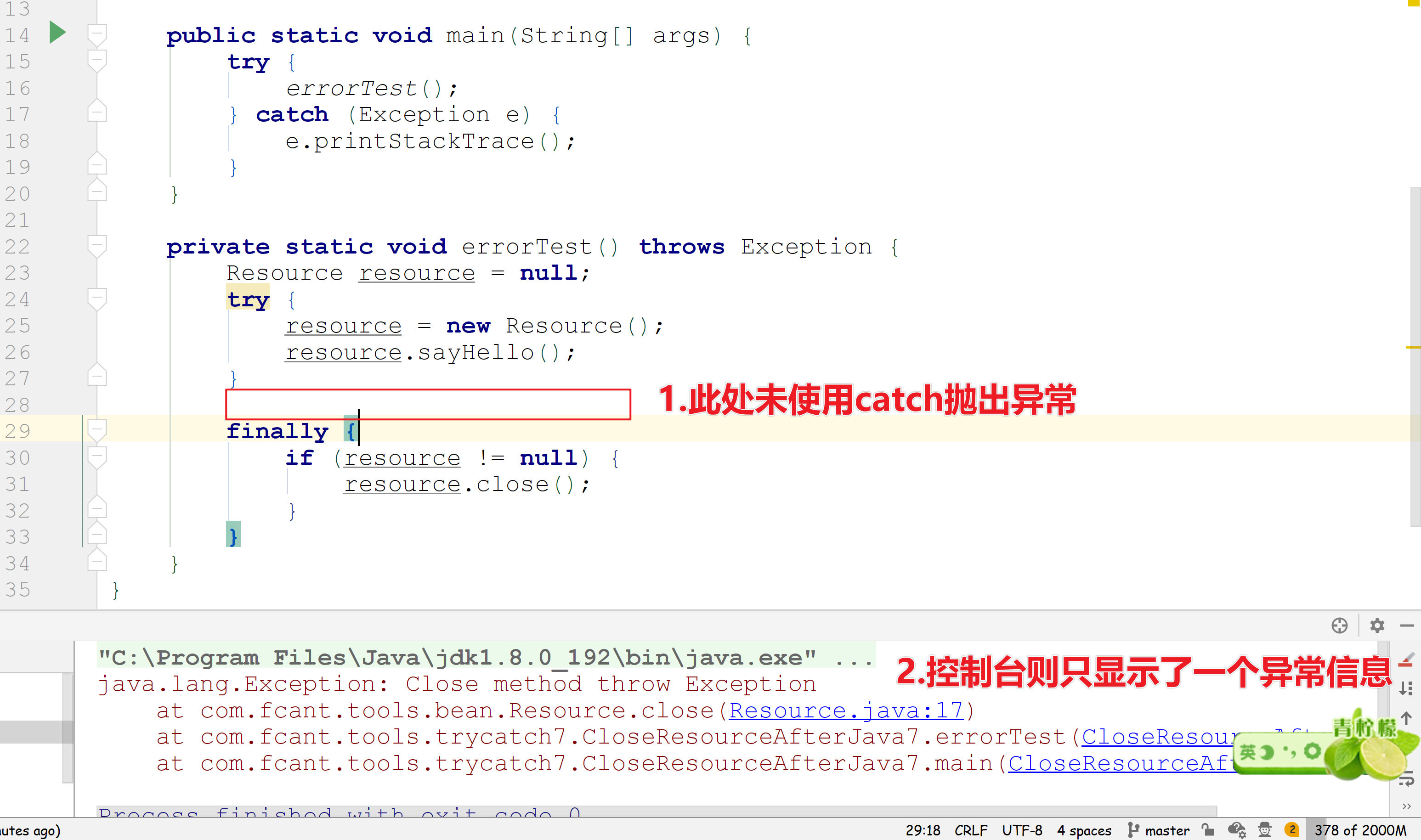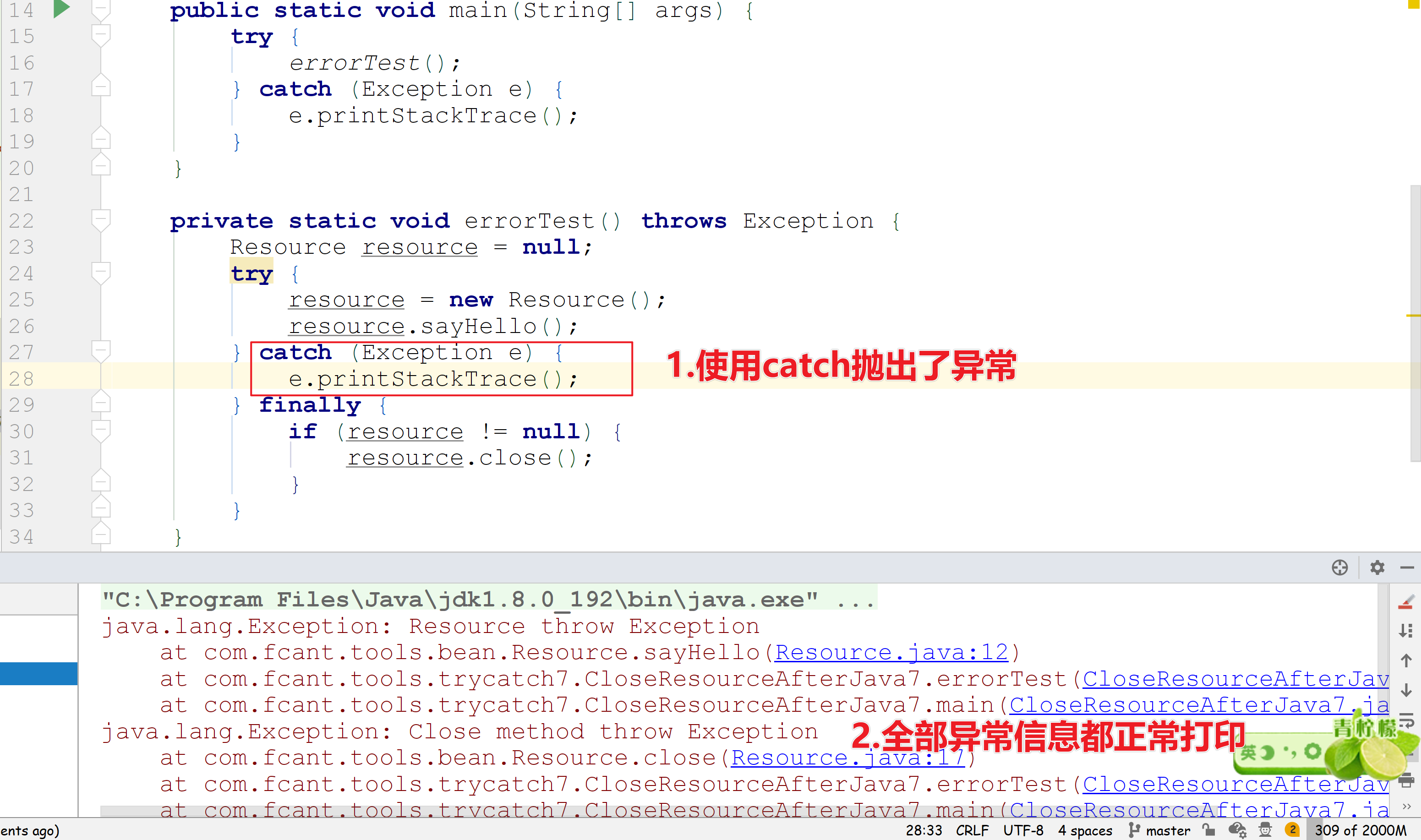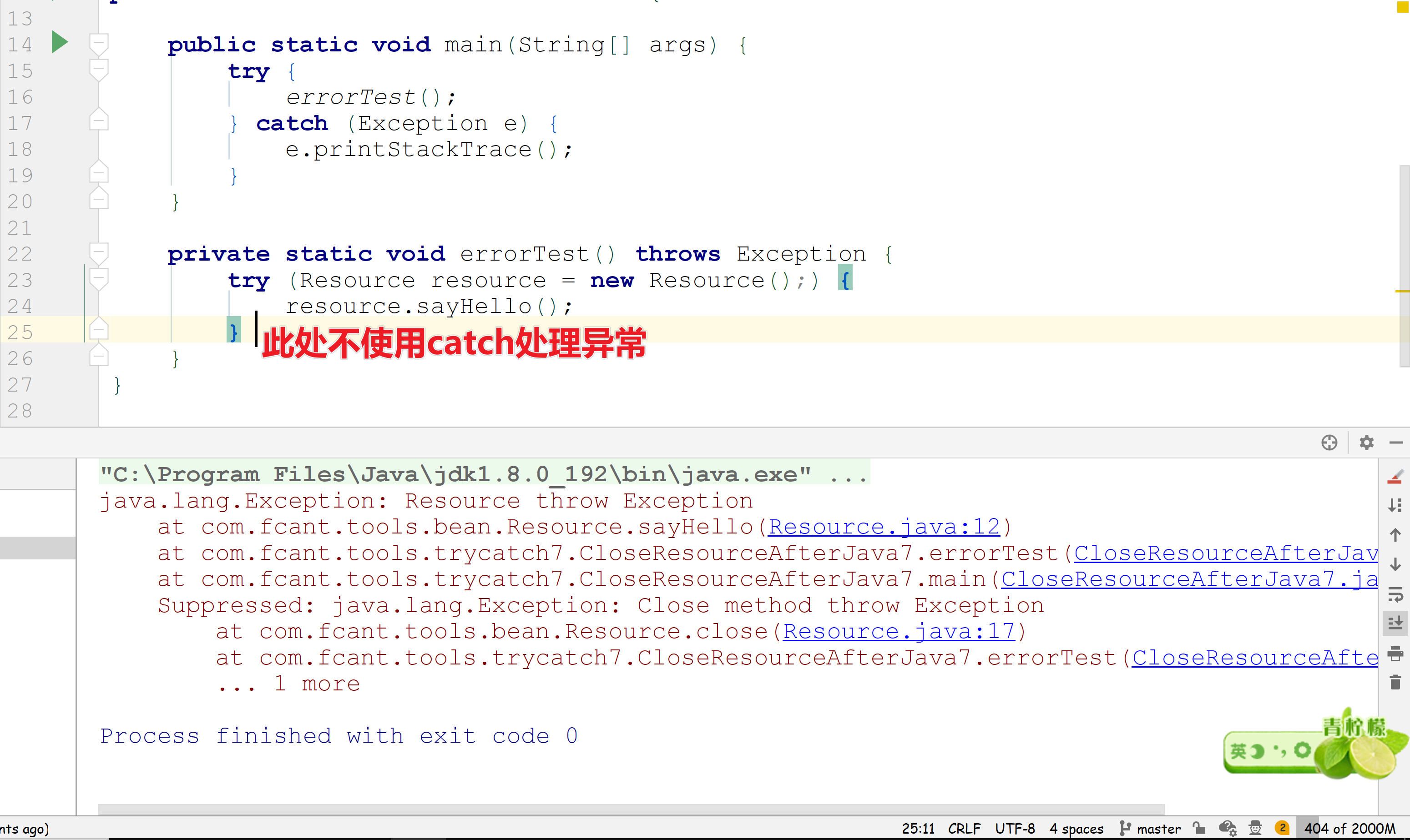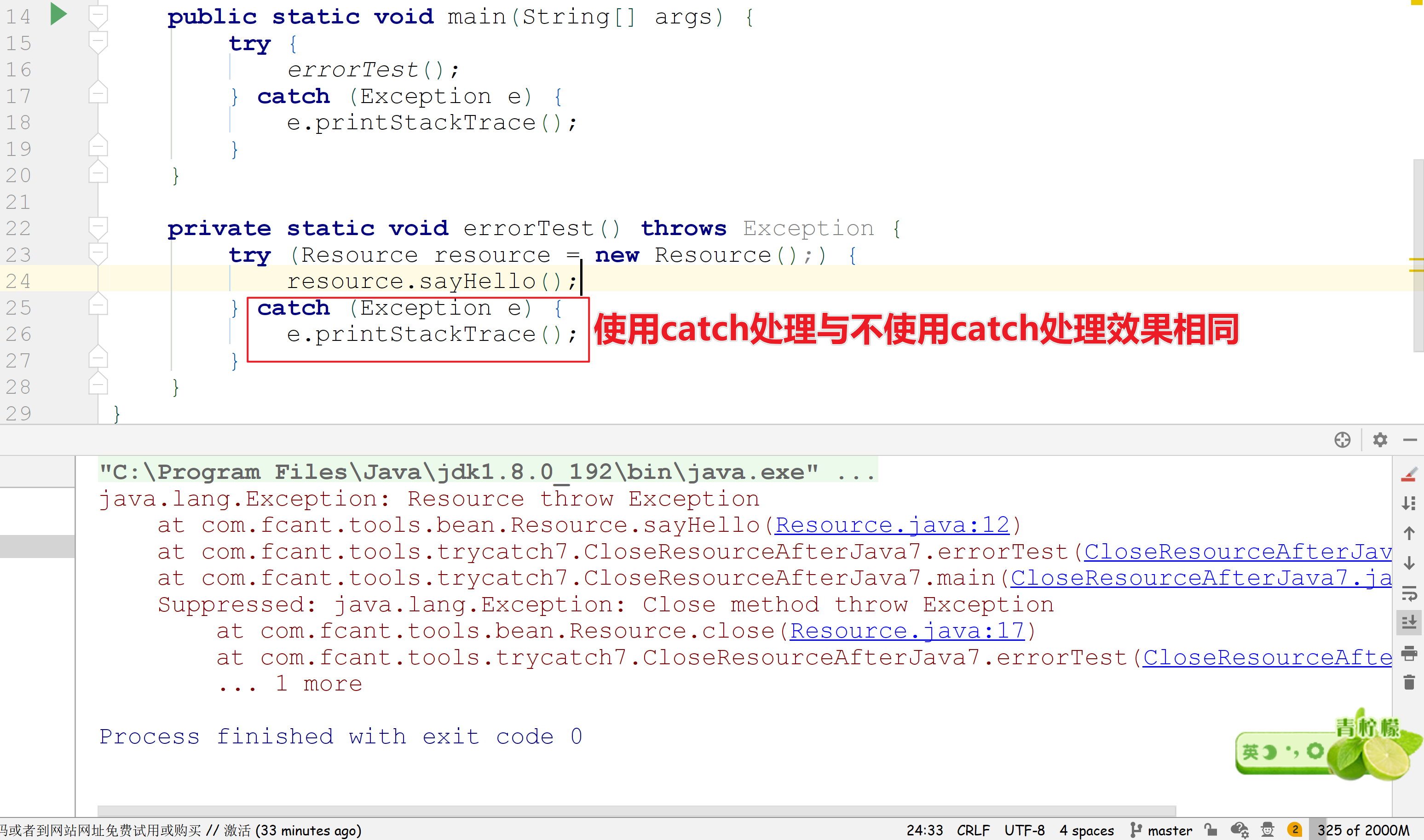1、jdk7之前的关闭流的操作
/*** jdk7以前关闭流的方式** @author fcant* */public class CloseResourceBeforeJava7 {private static final String FileName = "file.txt";public static void main(String[] args) throws IOException {FileInputStream inputStream = null;try {inputStream = new FileInputStream(FileName);char c1 = (char) inputStream.read();System.out.println("c1=" + c1);} catch (IOException e) {e.printStackTrace();} finally {if (inputStream != null) {inputStream.close();}}}}
2、jdk7之后try-with-resource关闭资源
实现了 **java.lang.AutoCloseable**接口(其中,它包括实现了 **java.io.Closeable** 的所有对象),可以使用作为资源。实现java.lang.AutoCloseable接口的Resource类:
/*** 资源类** @author fcant* */public class Resource implements AutoCloseable {public void sayHello() {System.out.println("hello");}@Overridepublic void close() throws Exception {System.out.println("Resource is closed");}}
/*** jdk7及以后关闭流的方式** @author fcant* */public class CloseResourceAfterJava7 {public static void main(String[] args) {try(Resource resource = new Resource()) {resource.sayHello();} catch (Exception e) {e.printStackTrace();}}}
输出:
helloResource is closed
当存在多个打开资源的时候:
/*** 资源2** @author fcant* */public class Resource2 implements AutoCloseable {public void sayhello() {System.out.println("Resource say hello");}@Overridepublic void close() throws Exception {System.out.println("Resource2 is closed");}}
/*** jdk7及以后关闭流的方式** @author fcant* */public class CloseResourceAfterJava7 {public static void main(String[] args) {try(Resource resource = new Resource(); Resource2 resource2 = new Resource2()) {resource.sayHello();resource2.sayhello();} catch (Exception e) {e.printStackTrace();}}}
输出:
helloResource say helloResource2 is closedResource is closed
3、关于异常屏蔽
A.Java7之前-不使用catch抛出异常的写法
将上面的测试类进行修改使用方法抽取异常处理不使用catch抛出异常
/*** CloseResourceAfterJava7* <p>* encoding:UTF-8** @author Fcant 下午 22:04 2020/6/26/0026*/public class CloseResourceAfterJava7 {public static void main(String[] args) {try {errorTest();} catch (Exception e) {e.printStackTrace();}}private static void errorTest() throws Exception {Resource resource = null;try {resource = new Resource();resource.sayHello();}finally {if (resource != null) {resource.close();}}}}
B.Java7之前-使用catch抛出异常的写法
/*** CloseResourceAfterJava7* <p>* encoding:UTF-8** @author Fcant 下午 22:04 2020/6/26/0026*/public class CloseResourceAfterJava7 {public static void main(String[] args) {try {errorTest();} catch (Exception e) {e.printStackTrace();}}private static void errorTest() throws Exception {Resource resource = null;try {resource = new Resource();resource.sayHello();} catch (Exception e) {e.printStackTrace();} finally {if (resource != null) {resource.close();}}}}
C.Java7之后-显示被Suppressed屏蔽(未使用catch抛出)[即A中的问题]的异常
①不使用catch处理异常
/*** CloseResourceAfterJava7* <p>* encoding:UTF-8** @author Fcant 下午 22:04 2020/6/26/0026*/public class CloseResourceAfterJava7 {public static void main(String[] args) {try {errorTest();} catch (Exception e) {e.printStackTrace();}}private static void errorTest() throws Exception {try (Resource resource = new Resource();) {resource.sayHello();}}}
②使用catch处理异常与不使用catch一样
/*** CloseResourceAfterJava7* <p>* encoding:UTF-8** @author Fcant 下午 22:04 2020/6/26/0026*/public class CloseResourceAfterJava7 {public static void main(String[] args) {try {errorTest();} catch (Exception e) {e.printStackTrace();}}private static void errorTest() throws Exception {try (Resource resource = new Resource();) {resource.sayHello();} catch (Exception e) {e.printStackTrace();}}}
D.分析编译后的class文件查看AutoCloseable怎么处理屏蔽的异常
以下是测试类编译后的class源码文件,并非研究操作的功能源码
public class CloseResourceAfterJava7 {public CloseResourceAfterJava7() {}public static void main(String[] args) {try {errorTest();} catch (Exception var2) {var2.printStackTrace();}}private static void errorTest() throws Exception {Resource resource = new Resource();Throwable var1 = null;try {resource.sayHello();} catch (Throwable var10) {var1 = var10;throw var10;} finally {if (resource != null) {if (var1 != null) {try {resource.close();} catch (Throwable var9) {var1.addSuppressed(var9);}} else {resource.close();}}}}}

可以发现编译以后生成了try-catch-finally语句块 finally中的var1.addSuppressed(var9);
这里可以看到AutoCloseable底层已经转换了try catch,所以我们可以不用catch抛出异常。
另外如果我们写的不够优雅,IDEA也会提示进行转换的